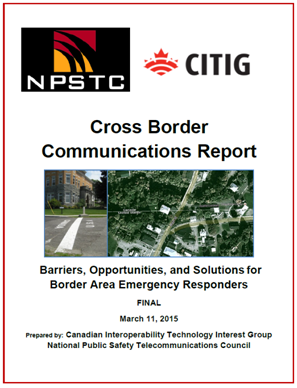March 11, 2015, The Canadian Interoperability Technology Interest Group (CITIG) and the National Public Safety Telecommunications Council (NPSTC) are pleased to announce the publication of their Cross Border Communications Report: Barriers, Opportunities, and Solutions for Border First Responders, a comprehensive study of cross border public safety communications at the local first responder level. The report is designed to clarify legal and regulatory policies, identify best practices and examples of interoperability excellence, and advance specific recommendations to enhance public safety communications at the national border.
Cross border public safety communications is a complex issue that affects all first responder organizations which operate near the U.S. and Canadian border. The inability to directly communicate with other emergency responders puts both property and the lives of responders and the public they seek to protect at risk. 
Fire departments, law enforcement, and EMS organizations are frequently asked to cross the national border to render aid. They may be the primary agency assigned to respond to an emergency across the border. Some public safety agencies coordinate with officials at border crossings and have developed close working relationships while other first responder organizations operate in rural areas and must deal with border crossings which are closed overnight.
The inability to communicate across the borders is related to regulatory and technology barriers, disparate and proprietary technology solutions, and uncertainty as to whether agencies can legally execute mutual aid agreements and operational policy directives with sister agencies across the border.
The Cross Border Communications Report lists and explains public safety requirements for cross border communications; addresses barriers and opportunities; includes current treaties and regulations with explanations; provides best practice examples; and ends with a comprehensive set of recommendations. Appendices provide additional valuable Internet resources.
